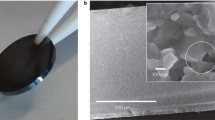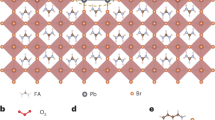Abstract
In semiconductor radiation detectors, leakage current is a major noise source affecting energy resolution and sensitivity. The surface passivation technology can reduce this leakage current and hence significantly enhance detector performance. Here, we demonstrate a facile way to passivate the surface of the nuclear detectors based on Methylammonium Lead Iodide (MAPbI\(_3\)) single crystals using soaking treatment in ethanol. A dense passivation layer of PbI\(_2\) was formed on the crystal surface, significantly reducing the surface leakage current by an order of magnitude under the same voltage. The energy resolution of the MAPbI\(_3\)-based detector is therefore improved by nearly 10% for the detection of 59.5 KeV irradiated from \(^{241}\)Am. Therefore, the PbI\(_2\) passivation by ethanol-soaking treatment is proved to be an effective method to reduce leakage current and improve detection performance.



Similar content being viewed by others
Data availability
The datasets generated during and/or analyzed during the current study are available from the corresponding author on reasonable request.
References
P.M. Johns, J.C. Nino, Room temperature semiconductor detectors for nuclear security. J. Appl. Phys. 126, 040902 (2019)
T. Schlesinger et al., Cadmium zinc telluride and its use as a nuclear radiation detector material. Mater. Sci. Eng. R. Rep. 32, 103–189 (2001)
K. Hitomi, T. Shoji, K. Ishii, Advances in tlbr detector development. J. Cryst. Growth 379, 93–98 (2013)
L. van den Berg, R.D. Vigil, Fabrication of mercuric iodide radiation detectors. Nucl. Instrum. Methods Phys. Res. Sect. A 458, 148–151 (2001)
M.D. Alam, S.S. Nasim, S. Hasan, Recent progress in cdznte based room temperature detectors for nuclear radiation monitoring. Prog. Nucl. Energy 140, 103918 (2021)
Q. Dong et al., Electron-hole diffusion lengths> 175 \(\mu\)m in solution-grown ch3nh3pbi3 single crystals. Science 347, 967–970 (2015)
X. Liu et al., Mapbbr3- x i x crystals improved by accurate solution-grown procedure for alpha particle detection. Front. Phys. 7, 232 (2020)
E. Lukosi et al., Methylammonium lead tribromide semiconductors: Ionizing radiation detection and electronic properties. Nucl. Instrum. Methods Phys. Res. Sect. A 927, 401–406 (2019)
W. Wang et al., Electronic-grade high-quality perovskite single crystals by a steady self-supply solution growth for high-performance x-ray detectors. Adv. Mater. 32, 2001540 (2020)
S. Yakunin et al., Detection of gamma photons using solution-grown single crystals of hybrid lead halide perovskites. Nat. Photonics 10, 585–589 (2016)
D. Shi et al., Low trap-state density and long carrier diffusion in organolead trihalide perovskite single crystals. Science 347, 519–522 (2015)
M.I. Saidaminov et al., High-quality bulk hybrid perovskite single crystals within minutes by inverse temperature crystallization. Nat. Commun. 6, 7586 (2015)
Y. He et al., Resolving the energy of \(\gamma\)-ray photons with mapbi3 single crystals. ACS Photonics 5, 4132–4138 (2018)
N. Aristidou et al., Fast oxygen diffusion and iodide defects mediate oxygen-induced degradation of perovskite solar cells. Nat. Commun. 8, 15218 (2017)
J. Zhou et al., Understanding the passivation mechanisms and opto-electronic spectral response in methylammonium lead halide perovskite single crystals. ACS Appl. Mater. Interfaces 10, 35580–35588 (2018)
F. Ambrosio, D. Meggiolaro, E. Mosconi, F. De Angelis, Charge localization and trapping at surfaces in lead-iodide perovskites: the role of polarons and defects. J. Mater. Chem. A 8, 6882–6892 (2020)
L. Zheng et al., Alcohol assistant surface passivated perovskites for efficient perovskite solar cells. Org. Electron. 111, 106653 (2022)
K. Kim et al., Detector performance of ammonium-sulfide-passivated cdznte and cdmnte materials. Hard X-Ray Gamma-Ray Neutron Detect. Phys. XII 7805, 356–361 (2010)
I.O. Okwechime et al., Chemical treatment of cdznte radiation detectors using hydrogen bromide and ammonium-based solutions. Hard X-Ray Gamma-Ray Neutron Detect. Phys. XVI 9213, 165–169 (2014)
S. U. Egarievwe, et al., Effects of surface passivation on cdzntese nuclear detectors. In 2021 IEEE Nuclear Science Symposium and Medical Imaging Conference (NSS/MIC) (2021)
S.U. Egarievwe, U.N. Roy, C.A. Goree, B.A. Harrison, R.B. James, Ammonium fluoride passivation of cdzntese sensors for applications in nuclear detection and medical imaging. Sensors 19, 3271 (2019)
M.L. Drabo et al., Analysis of te and teo\(_2\) on cdznte nuclear detectors treated with hydrogen bromide and ammonium-based solutions. J. Mater. Sci. Chem. Eng. (2017). https://doi.org/10.4236/msce.2017.54002
M. Loizos, M. Tountas, P. Mangelis, K. Rogdakis, E. Kymakis, Surface passivation of sequentially deposited perovskite solar cells by octylammonium spacer cations. APL Energy 1, 026102 (2023)
T.-H. Wu, G.D. Sharma, F.-C. Chen, Surface-passivated single-crystal micro-plates for efficient perovskite solar cells. Processes 10, 1477 (2022)
A. Cook et al., Passivation by pyridine-induced pbi2 in methylammonium lead iodide perovskites. RSC Adv. 10, 23829–23833 (2020)
Q. Jiang et al., Surface passivation of perovskite film for efficient solar cells. Nat. Photonics 13, 460–466 (2019)
T. Wang, F. Xu, Q. Wang, L. Tai, G. Xu, Improved perovskite structural stability by halogen bond from excessive lead iodide via numerical simulation. Curr. Comput.-Aided Drug Des. 12, 1073 (2022)
Y. Zhang et al., Auto-passivation of crystal defects in hybrid imidazolium/methylammonium lead iodide films by fumigation with methylamine affords high efficiency perovskite solar cells. Nano Energy 58, 105–111 (2019)
J. Wu et al., A modified sequential deposition route for high-performance carbon-based perovskite solar cells under atmosphere condition. Molecules 27, 481 (2022)
R. Xu et al., Uncovering the formation mechanism of striations and pyramidal pits on a native mapbi3 single-crystal surface. J. Phys. Chem. C 126, 7319–7325 (2022)
Z. Wang, Q. Lin, F.P. Chmiel, N. Sakai, H.J. Snaith, Efficient ambient-air-stable solar cells with 2d–3d heterostructured butylammonium-caesium-formamidinium lead halide perovskites. Nat. Energy 2, 17135 (2017)
Y. Liu, S. Akin, L. Pan, R. Uchida, M. Grtzel, Ultrahydrophobic 3d/2d fluoroarene bilayer-based water-resistant perovskite solar cells with efficiencies exceeding 22. Sci. Adv. 5, eaaw2543 (2019)
W.Q. Wu et al., Bilateral alkylamine for suppressing charge recombination and improving stability in blade-coated perovskite solar cells. Sci. Adv. (2019). https://doi.org/10.1126/sciadv.aav8925
M. Prokesch, C. Szeles, Accurate measurement of electrical bulk resistivity and surface leakage of cdznte radiation detector crystals. J. Appl. Phys. 100, 014503 (2006)
A. Kargar, H. Kim, L. Cirignano, K. Shah, The effect of guard ring on leakage current and spectroscopic performance of tlbr planar detectors. Radiat. Detect.: Syst. Appl. XV 9215, 77–85 (2014)
A. Ruzin, Y. Nemirovsky, Passivation and surface leakage in cdznte spectrometers. Appl. Phys. Lett. 71, 2214–2215 (1997)
Y. Nemirovsky, G. Asa, C. Jakobson, A. Ruzin, J. Gorelik, Dark noise currents and energy resolution of cdznte spectrometers. J. Electron. Mater. 27, 800–806 (1998)
A. Bolotnikov, G. Camarda, G. Wright, R. James, Factors limiting the performance of cdznte detectors. IEEE Trans. Nucl. Sci. 52, 589–598 (2005)
Acknowledgements
The authors acknowledge the financial support from the National Natural Science Foundation of China (Grant No. 12175131), the Opening Foundation of Zhejiang Engineering Research Center of MEMS(Grant No. MEMSZJERC2302). Thanks are due to Xu Haitao for assistance with the AFM experiments .
Funding
This work was supported by the National Natural Science Foundation of China (Grant No. 12175131), the Opening Foundation of Zhejiang Engineering Research Center of MEMS(Grant No. MEMSZJERC2302).
Author information
Authors and Affiliations
Contributions
All authors contributed to the study’s conception and design. Material preparation, data collection, and analysis were performed by ZJ, CG, WH, YH, WW, XR. The first draft of the manuscript was written by ZJ and all authors commented on previous versions of the manuscript. All authors read and approved the final manuscript.
Corresponding authors
Ethics declarations
Conflict of interest
The authors have no relevant financial or non-financial interests to disclose.
Additional information
Publisher's Note
Springer Nature remains neutral with regard to jurisdictional claims in published maps and institutional affiliations.
Supplementary Information
Below is the link to the electronic supplementary material.
Rights and permissions
Springer Nature or its licensor (e.g. a society or other partner) holds exclusive rights to this article under a publishing agreement with the author(s) or other rightsholder(s); author self-archiving of the accepted manuscript version of this article is solely governed by the terms of such publishing agreement and applicable law.
About this article
Cite this article
Jiajie, Z., Gang, C., Hao, W. et al. The effect of the PbI\(_2\) surface passivation on the leakage current for MAPbI\(_3\) single crystal nuclear detectors. J Mater Sci: Mater Electron 35, 450 (2024). https://doi.org/10.1007/s10854-024-12117-2
Received:
Accepted:
Published:
DOI: https://doi.org/10.1007/s10854-024-12117-2




